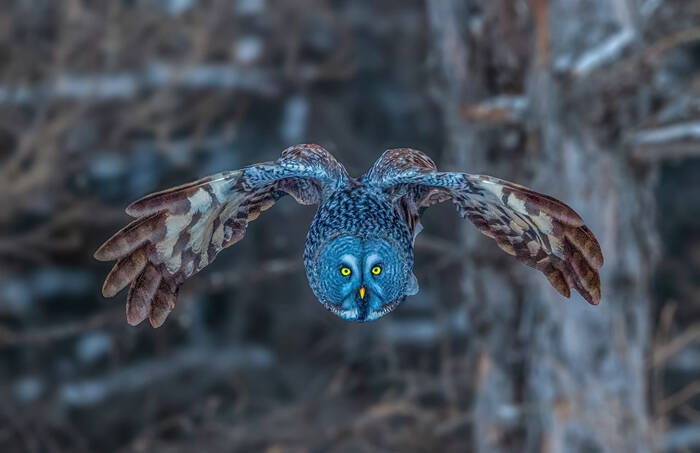Strix nebulosa
IUCN
LCBasic Information
Scientific classification
- name:Strix nebulosa
- Scientific Name:Strix nebulosa,Great Grey Owl
- Outline:Raptor
- Family:Strigiformes Owl
Vital signs
- length:56-64cm
- Weight:750-1005g
- lifetime:5-15years
Feature
The head is large, without ear tufts, and the face is prominent, round, light gray, and covered with concentric dark rings and crescent-shaped white spots.
Distribution and Habitat
In China, the Great Gray Owl is distributed in Tahe, Huma, Daxinganling, Heilongjiang, Genhe, Boktu, and Horqin Right Front Banner of Hulunbuir League in Inner Mongolia. Outside China, it is distributed in northern Eurasia and North America, from the Scandinavian Peninsula and Finland, through the European part of the former Soviet Union, the southern edge of the Siberian Taiga, and the Kenda Mountains in northern Mongolia, all the way east to Alaska, Canada, and California, Idaho, and western Montana in the United States.
The Great Gray Owl mainly inhabits primitive coniferous forests and mixed coniferous and broad-leaved forests dominated by larch, birch, and poplar, and sometimes also in valley mixed woods and near forest residences.
Appearance
The Great-Wilded Owl has a large, round head and a prominent, disc-shaped, gray or off-white face with some wavy black concentric circles. The eyes, above and under the eyes are white and connected together to form obvious crescent-shaped spots. The ruff feathers are very dense, dark brown and mixed with white horizontal spots. The upper body is grey-brown with white horizontal spots, beetle-like spots and brown feather stripes, especially the thick vertical stripes on the back, white shoulders, and almost pure white outer limbs with a few brown horizontal spots. The primary coverts and minor wing feathers on the wings are darker brown, and the white spots are not obvious. The outer coverts of the major coverts and middle coverts have large white oval spots. The flight feathers are dark brown with light brown horizontal spots, and the inner feathers are dark brown. The secondary flight feathers also have light brown horizontal spots, and the outer feathers are slightly white. Show. The
Details
Great Grey Owl is a large owl with two subspecies.

Except during the breeding season, the Great Grey Owl often moves alone, flies quickly and silently, and often rests on the top of tall trees, waiting and observing prey. It is active and hunts at night, and sometimes during the day and dusk. It mainly feeds on rodents, and also eats small and medium-sized birds, such as chickens. It has a very sharp hearing, with the largest hearing perception area between 3000-6000Hz, and can clearly hear the high-frequency screams of rodents. The call is rough and monotonous, mostly at night, and its sound is like "hu-hu-hu-hu-hu". The courtship call is a series of 10 or more "hu-hu" sounds, with a half-second interval, and the tone and volume gradually fade at the end. The female bird responds with a weak "chieop-chiepp-chiepp" sound. The alarm call is a low and sharp "grrroooo" sound.
The breeding season of the Great Grey Owl is from May to July. Usually nests are built on trees, mostly on the top of broken trees, sometimes also invade the nests of other raptors and large birds, and are mostly 6-10 meters from the ground. The nest is shallow cup-shaped, with an outer diameter of 95-110 cm, an inner diameter of 28-35 cm, and a height of 40-65 cm. The nest is very simple, mainly made of dead branches, with a small amount of pine needles and feathers inside. Each nest lays 3-5 eggs, mostly 4. The eggs are white or grayish white, oval in shape, 49-58 mm × 39-45 mm in size, 54.1 mm × 42.5 mm on average, and 51.2 grams on average. The female bird incubates the eggs, usually starting to incubate after the first egg is laid, and the incubation period is 30 days. The chicks are late-maturing, and the newly hatched chicks weigh only 51.7 grams and are 96-115 mm long. Only the top of the head, neck, upper back and wings are sparsely covered with milky white down feathers, and the rest are bare and featherless, with flesh-red skin.
The Great Gray Owl has a wide distribution range and is not close to the critical value of vulnerable and endangered species survival (distribution area or fluctuation range less than 20,000km², habitat quality, population size, and fragmented distribution area). The population trend is rising, so it is evaluated as a species of least concern.
The Great Gray Owl has been included in the 2012 Red List of Endangered Species of the World Conservation Union (IUCN) ver 3.1-Least Concern (LC).
The Great Gray Owl has been included in the "National Key Protected Wildlife List" issued by the Ministry of Forestry and the Ministry of Agriculture of China on January 14, 1989 as a Class II protected animal.
Protect wild animals and stop eating game.
Maintaining ecological balance is everyone's responsibility!








